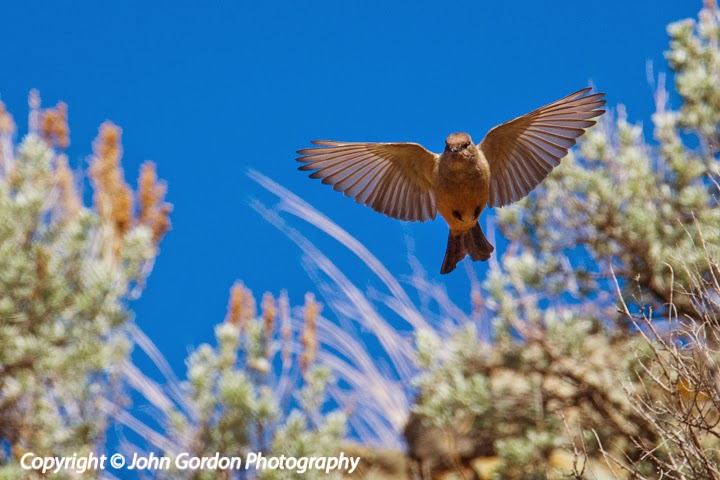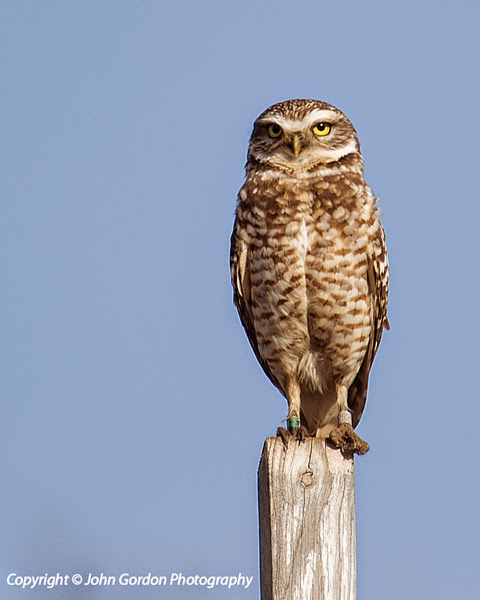 |
| The Burrowing Owl nests underground usually in disused badger dens of which I don't think there are any. Instead man made burrows have been built to offer shelter and nesting. |
The sounds of the Meadowlarks call carrying across the grasslands was breathtaking. Fleeting views of a Northern Shrike and Vesper Sparrows were just a taste of what is to come. Soon Horned Larks and Clay-coloured Sparrows will arrive en masse.
 |
| Western Meadowlark ( |
We made our way back toward Kamloops and on to the Tranquille area. At Rattlesnake Bluffs we searched for Canyon Wrens but no luck, we were however visited by an accommodating Say's Phoebe.
Rattlesnake Bluffs
Nature Conservancy of Canada Property
 |
| Say's Phoebe (Sayornis saya) |
Sunlight reflected off the canyon walls lights up the wings of dainty flycatcher. This is a good place for Chukar, Canyon Wren and nesting White-throated Swallows.
Say's Phoebe feed on insects and can be very vocal and are easily approached compared with some species.
 |
| Bighorn Sheep at Vaseux Lake. |
 |
| Chukar (Alectoris chukar) Tamron 150mm-600mm |
*****************
Leaving for Kelowna we looked for less travelled areas where we spotted both Western or Mountain Bluebirds hawking insects. Many were already populating nest boxes. Soon the Lazuli Bunting will be arriving adding to the colourful display.
 |
| Pygmy Nuthatch (Sitta pygmaea) Tamron 150mm-60mm handheld |
In the trees Pygmy Nuthatches were excavating nest holes and squabbles between Northern Flickers and European Starlings provided an entertaining distraction from looking for owls. On a previous trip I found one particular tree with all the above three species nesting within feet of each other.
Moving on we had a tip from a local birder that a Western Screech Owl had been seen so we searched and found a spot with enough "whitewash" to indicate an owl had indeed used the tree to roost. We returned at ten o'clock that night and after an hour and applying a few calls a Western Screech Owl flew into a closeby branch. Having never photographed owls at night I had no idea to expose for the shot so my images are dismal...... to their credit Brian and Roy got some nice images. We got back to our hotel at 2 a.m completely knackered.
******
******
Next day working on another tip we tried another spot but again no owl. We moved on deciding to return later in the day.
We left the balmy weather of the Okanagan Valley with blue skies and cherry blossom for the high mountain logging roads where it was cold and grey. Our search for woodpeckers was fruitless, we could hear them but had to settle for flocks of Mountain Chickadees, a bird I haven't seen too much of and was quite happy to photograph. I would have liked to have stayed longer but birders don't hang around like photographers. I must be a hybrid because I can do both but not at the same time!
 |
| Mountain Chickadee (Poecile gamble) |
 |
| Western Screech Owl (Otus kennicottii) |
Finally an owl in daylight, something I could manage and after blowing the shot the night before I felt a lot better, finally I have a decent image of species that I had only seen once before.
Eventually the two day photo expedition came to an end. A huge thanks from all of us should go out to our fearless leader Mel who went way beyond the call of duty to make sure we had an interesting
itinerary. We covered 1300 kms from Vancouver to Kamloops and Osoyoos and back but without the effort we wouldn't have had such an amazing experience.
As an aside I will be trying out the new Nikon P900 24mm-2000mm bridge camera in the next few weeks. It might make a great birding lens for those who don't want to lug around too much gear and just want to post on Flickr and not be bothered with exhibition quality images. It even has a birding mode where it takes a high sequence of frames.
As an aside I will be trying out the new Nikon P900 24mm-2000mm bridge camera in the next few weeks. It might make a great birding lens for those who don't want to lug around too much gear and just want to post on Flickr and not be bothered with exhibition quality images. It even has a birding mode where it takes a high sequence of frames.
"It's never too late to start birding"
John Gordon
Langley/Cloverdale
Management takes no responsibility for grammatical errors.
Management takes no responsibility for grammatical errors.



























